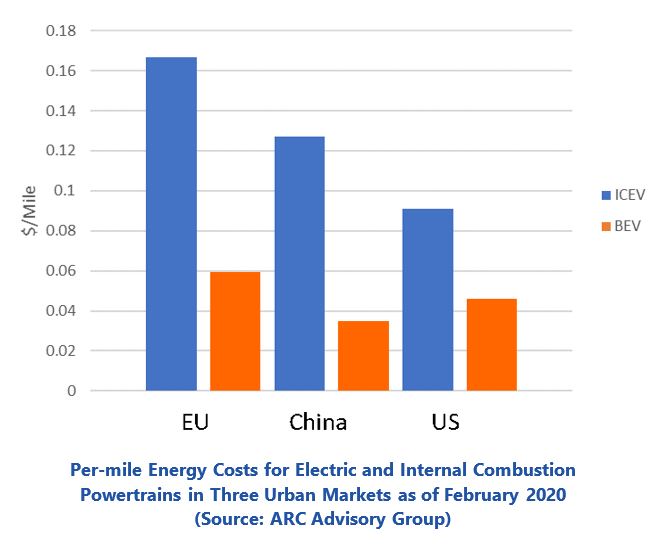

Transportation is one of the fastest changing and most exciting sectors in the global economy. Connected and autonomous vehicles, shared mobility concepts, and the shift to electric vehicles (collectively referred to as “CASE”) are some of the most exciting avenues. Of these, vehicle electrification is most mature.
Electrification has been gaining momentum recently, with millions of private light-duty vehicles on the road, nine- and ten-figure vehicle purchase orders on the commercial side, and vast investments by OEMs and suppliers in their EV programs.
At one of the Smart Cities sessions at ARC Advisory Group’s 24th annual Industry & City Forum, three leaders in the EV space joined our panel and discussed how vehicle electrification is becoming a reality, how charging can be done in harmony with the broader energy system, and the policies that will be needed to support the move to sustainable electric mobility.
Electric vehicles (EVs) have reached TCO parity with fossil fuel-powered vehicles for commercial applications and are becoming increasingly cost-effective for private drivers as well. More than seven million private light-duty vehicles are on the roads today. OEMs Tesla, Nissan, and GM have been active in the sector for years and the growing momentum has attracted vast commitments from VW/Audi, Ford, General Motors, Porsche, and others. On the commercial side, Chanje, Rivian, Volvo/Mack, Daimler, Proterra, BYD, and other players, large and small, are working to provide fleets with the workhorse vehicles they now demand, signaled by headline-making orders from FedEx, UPS, Amazon and others.

Beyond the lower energy costs, BEVs have fewer moving parts than internal combustion engine vehicles (ICEVs) and forgo liquid fuels entirely. The list of part replacements/maintenance/issues that BEV owners do not need to worry about includes:
What’s more, thanks to regenerative braking, BEV owners also often don’t have to replace the vehicle’s brakes as frequently.
Our first presenter, Chris Castro, Sustainability Director for the City of Orlando (which recently achieved LEED Gold certification as a sustainable city), shared what his city has been doing to promote sustainable (mostly electric) transport via the Green Works Orlando program.
Most EV charging is done at home, though some is done at work or at “destination” locations like shopping centers. More importantly, these publicly visible chargers serve to boost consumer confidence and help raise EV adoption. To this end, the City of Orlando has deployed hundreds of level 2 chargers in public spaces around the city in parks, recreation centers, and parking lots, with more coming soon.
To further accelerate infrastructure rollout, the city has developed a novel on-bill financing program in partnership with the municipal utility called the OUCharge-it program. A business with on-site parking can have level 2 or level 3 chargers installed on its property for its employees or customers to use with no upfront cost. The business then pays off the cost of that equipment on its electricity bill across a seven-year term.
The city is also targeting its own fleet, setting a goal of 100 percent electric or alternative fuel vehicles by 2030. Currently, the fleet has 179 of these (including hybrids), having secured discounted purchase costs by leveraging the Climate Mayors EV Purchasing Collaborative, a platform enabling cities to bid for EVs together.
To electrify the bus fleet, the city, utility, and transit authority created a new battery-as-a-service model. The utility buys and leases to the transit agency the battery and charging gear, and the operator makes the lease payment out of the sizeable fuel and maintenance savings that e-buses provide. After eight years, the utility replaces the battery with a new one and uses the older one for solar plus storage applications on the grid – a “public-public-public partnership” according to Mr. Castro.
Public Knowledge and perception are key to raising EV adoption. Home to world-class theme parks and other major attractions, the City of Orlando gets 75 million visitors in a year for a population under 300,000. This presents challenges to the city, but also a unique opportunity to expose people from all over the country and the world to EVs. Through the “Drive Electric Orlando” program, visitors to the city can rent an EV. This doubles as a VIP pass – earning them free priority parking at theme parks and lodging destinations. The city also hosts local EV ride-and-drive events to promote exposure and education around electric vehicles for its residents.
ARC Advisory Group clients can view the complete report at ARC Client Portal
If you would like to buy this report or obtain information about how to become a client, please Contact Us
Keywords: Electric Vehicles, Electric Vehicle Charging, Sustainability, Infrastructure Planning, Smart Cities, Battery Electric Vehicles, Vehicle Grid Integration, ARC Advisory Group.

